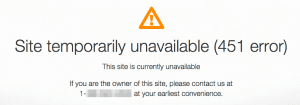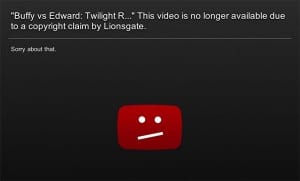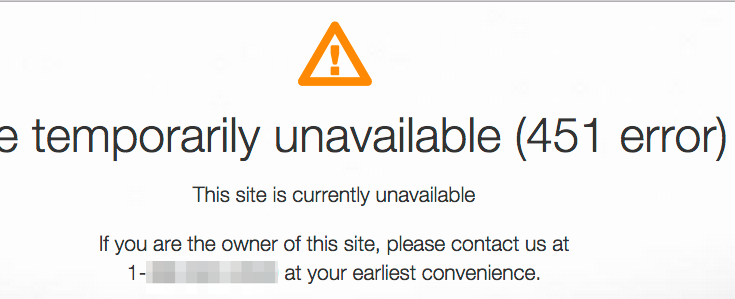HTTP Error 451: Unavailable for Legal Reasons
 Even if you aren’t particularly Web savvy, you likely already know some of the more common HTTP status codes. For example, error code 404 means that a file is not found, 403 means that you are forbidden access to it and 500 means that there was an internal server error.
Even if you aren’t particularly Web savvy, you likely already know some of the more common HTTP status codes. For example, error code 404 means that a file is not found, 403 means that you are forbidden access to it and 500 means that there was an internal server error.
These status codes, in particular the ones that represent errors, are meant to convey useful information to the viewer, letting them know why the resource that they trying to access can’t be pulled up.
For example, with a 404 error, the user knows that the file is gone but, with a 403 error they know it’s there but they don’t have permission to access it.
However, another proposed error code aims to shine the light on content removed for legal reasons: Code 451.
While it’s unclear if this will ever become an official code, already some web companies are using it and it’s likely others will follow suit, making it an error that will be more and more common, especially for content creators protecting their work.
The History of HTTP Error 451
The code itself was proposed in 2012 by Tim Bray, a Google employee, in response to site blocking legislation in the United Kingdom. According to Bray, he got the idea from a Blogspot user named Terence Eden, who discovered that his ISP was forced to block The Pirate Bay when he tried to access the site and got a 403 error, meaning that access was forbidden.
However, according to Bray and Eden, the 403 error was inappropriate. It’s meant for situations where the site itself is blocking access, such as someone who isn’t logged in but needs to be to view a page, not a situation where an ISP is forbidding access to it. Thus, Bray developed the idea for Error 451 to indicate sites, pages and other resources blocked for legal reasons.
The choice of number 451 is no coincidence. It’s a reference to Fahrenheit 451, the book by Ray Bradbury which features a dystopian future where books are forbidden and burned. According to Bray, he chose the number to make those who block materials on legal reasons nervous about doing so, saying that, while certain restrictions are necessary and can be agreed upon, they should be limited in their application.
The push for the new code generated a lot of of support in 2012 and 2013. Much of that support was spearheaded by a campaign by the Open Rights Group, who said that the error was needed for transparency.
However, not a great deal has been heard about the code since 2013 and the most recent news is that it remains a draft with the Internet Engineering Task Force (IETF), which oversees the HTTP code standards.
That being said, the process of a draft becoming a finalized code is a lengthy one so that isn’t necessarily a surprise. The case for Code 451 is further complicated by the fact that the code is also a Microsoft error code use with Outlook and has been for many years.
Still, even without the code being codified into the standard, some web hosts and providers are using it, at least in certain circumstances.
Finding Error 451 in the Wild
 If you file a copyright notice and a web host removes or disables access to the file or content, the most likely error that you’re going to get is a traditional 404 error, file not found.
If you file a copyright notice and a web host removes or disables access to the file or content, the most likely error that you’re going to get is a traditional 404 error, file not found.
This is because most web hosts will simply delete or remove the file(s) involved in the complaint, making it so that the page, image, etc. doesn’t exist and genuinely is not found.
Barring that, error 403 is the next most common. This happens when the host locks down a site or a page so that the public can’t view it, but the owner can access it and replace or remove the infringing material.
In both of those cases, the errors are working exactly as designed, but they aren’t indicating why the content was removed or restricted. When you receive a 404 error, you don’t know if you typed in the wrong URL, if the site administrator deliberately removed the content or if it was removed by the host. That’s the issue that supporters of Code 451 want it to correct.
However, some hosts have begun using error 451 in at least some circumstances. The largest I’ve seen is GoDaddy, which uses the error (as shown in the screen at the top) when it pulls down sites due to trademark complaints.
Still, use of Code 451 in the wild is extremely rare, especially for copyright complaints. Not only is it because the draft isn’t finalized, but because most sites and hosts either already have a custom error for when content is removed via a copyright notice, such as YouTube’s famous error, or they simply remove the content and use existing errors, which is easier.
But even if the error does begin to gain some traction, there are limitations to it that need to be addressed.
Limitations of Error 451
The first limitation to this error is the question about when it should be used. Unlike the other errors, this one is not purely technical and there is a lot of gray area about when the error is appropriate.
Take, for example, Gawker’s use of the error in 2013. Gawker published an article about the News of the World phone hacking scandal and, after receiving some legal advice, blocked access to the story from UK readers using Error 451.
However, there was no evidence that there was a court order or other legal action that forced Gawker to do it. They simply felt it wasn’t sound legally to leave the story accessible to UK readers. Given that the error is supposed to be used when third parties are requiring content to be removed, it seems, at best, to be a stretch of the error.
But the bigger problem is that the error can simply be worked around easily by judges or legislators. As was pointed out on the Naked Security blog, there’s nothing stopping judges or legislators to simply add the error code they want a site or piece of content blocked with. So, even if Code 451 is available, it means nothing if the intermediaries are required to use 404 or 403.
So while hosts and ISPs may have the choice to use it in certain cases, in many, such as court-ordered site blocking, it may not be an option. However, those cases were the exact ones core to the creation of the code, greatly limiting its usefulness in completing its desired mission.
Bottom Line
If Code 451 becomes a standard, that doesn’t mean it will see widespread use. Other codes are easier for hosts, courts and legislators can work around it and there is a fair amount of ambiguity about when it is supposed to be used.
That being said, I’m not opposed to the idea of transparency when items are removed for legal reasons. A lot of sites already do this, replacing generic 404 pages with notices about why the content was removed. The issue I have is that, with Code 451, this transparency comes with stigma.
There are many legitimate reasons why content should be pulled down and comparing the removal of the content with a dystopian future that banned all books seems a bit excessive.
When a revenge porn victim fights to get their images removed, should they be equated, even marginally, with book burning and censorship? There are many legitimate reasons for content to be removed that aren’t dystopian in any regard.
Still, the idea of a code indicating the reason the content removed is in and of itself not a terrible idea. But the implementation of it is going to be tricky and, even if it becomes a reality, it may never be as familiar as the codes we already see regularly.
Want to Reuse or Republish this Content?
If you want to feature this article in your site, classroom or elsewhere, just let us know! We usually grant permission within 24 hours.
